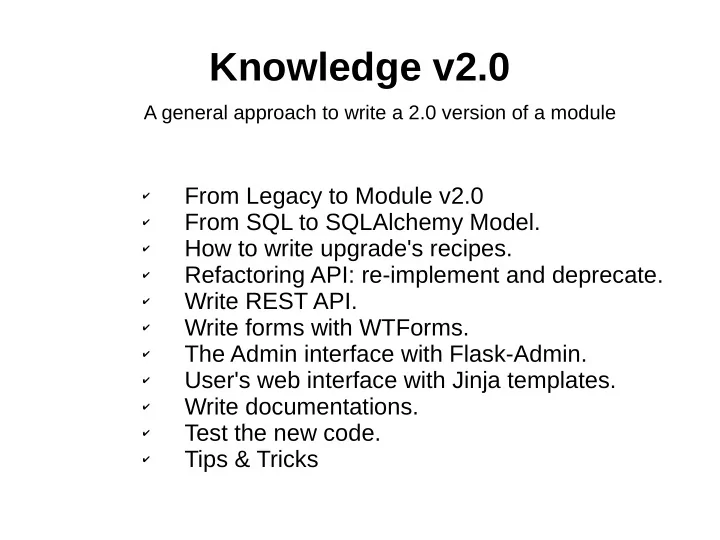

Knowledge v2.0 A general approach to write a 2.0 version of a module ✔ From Legacy to Module v2.0 ✔ From SQL to SQLAlchemy Model. ✔ How to write upgrade's recipes. ✔ Refactoring API: re-implement and deprecate. ✔ Write REST API. ✔ Write forms with WTForms. ✔ The Admin interface with Flask-Admin. ✔ User's web interface with Jinja templates. ✔ Write documentations. ✔ Test the new code. ✔ Tips & Tricks
From Legacy to Module v2.0 In the beginning was the legacy code invenio/legacy/bibknowledge/
From Legacy to Module v2.0 Then, Legacy transition to “module v2.0” invenio/legacy/bibknowledge/ Note : the legacy code use our new module. adminlib.py admin.py citation_indexer.py invenio/module/knowledge/
From Legacy to Module v2.0 In the end, only “module v2.0” survive invenio/legacy/bibknowledge/ invenio/module/knowledge/
From Legacy to Module v2.0 How a module is composed? Admin UI with Flask-Admin API accessible from outside All your defined WTForms SQLALchemy models REST API implementation Jinja2 templates Testsuites Upgrade recipes User UI
From SQL to SQLAlchemy Model From run_sql() To models.py Where in legacy code is used run_sql() , now it'll be replaced with the usage of SQLAlachemy (better if incapsulate the use of the model inside your api)
How to write upgrade's recipes (1/2) Old data model vs New data model: how to upgrade your database in production environment without break all? # Use the old Database $> git checkout pu $> inveniomanage database recreate –yes-i-know # With the new Codebase $> git checkout mybranch $> inveniomanage upgrader create recipe -a -p invenio.modules.knowledge # Finish to prepare your recipe $> vim invenio/modules/knowledge/upgrades/knowledge_2015_02_16_rename_me.py
How to write upgrade's recipes (2/2) Alembic is a database migrations tool written It help you to write python code to upgrade the database
Refactoring API: re-implement and deprecate. Each request have to pass from api (no direct access to models). ● Respect the old API (backward compatibility), meanwhile deprecate ● not useful code and implement a new cool API. Models API Input Output Black Box
Write REST API Define the object structure Define a resource Define the endpoints
Write forms with WTForms
The Admin interface with Flask-Admin Admin interface for Knowledge Define endpoints
The Admin interface with Flask-Admin
User's web interface with Jinja templates Define where load the templates (in this case invenio/modules/groups/ templates ) Your template The objects passed to the template
Write documentations E.g. docs/modules/redirector.rst Generate documentation $> sphinx-build -qnNW docs docs/_build/html E.g : Define where find the documentation for the section “Model”
Test the new code Load db interface ● Start your test: $> cd invenio/modules/knowledge/testsuite $> py.test test_knowledge_restful.py Note : import only when you need it (inside the function where you use it).
Tips & Tricks Use devscrips to install invenio2: Debugging configuration : ● ● https://github.com/tiborsimko/invenio-devscripts SQLALCHEMY_ECHO=True ASSETS_DEBUG = True Database create/drop : DEBUG = True ● inveniomanage database create TESTING = True inveniomanage database drop –yes-i-know Configuration file : inveniomanage database recreate –yes-i-know ● cdvirtualenv var/invenio.base-instance/ Start server : vim invenio.cfg ● inveniomanage runserver Jasmine tests : ● Install all dependency : http://0.0.0.0:8080/jasmine/specrunner ● pip install -e . --process-dependency-links Python tests : ● Install Kwalitee : python setup.py test ● pip install kwalitee kwalitee githooks install
Recommend
More recommend